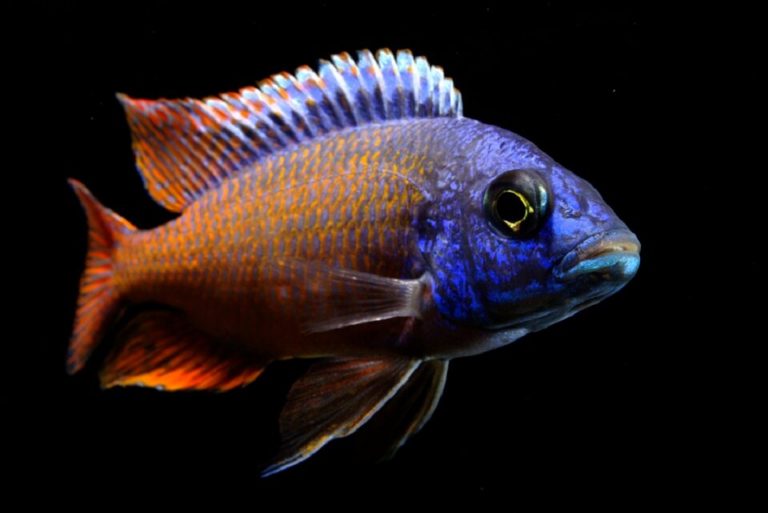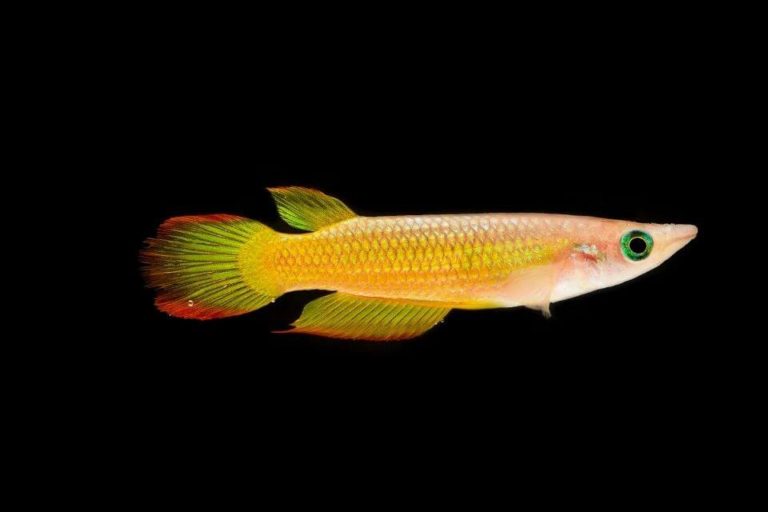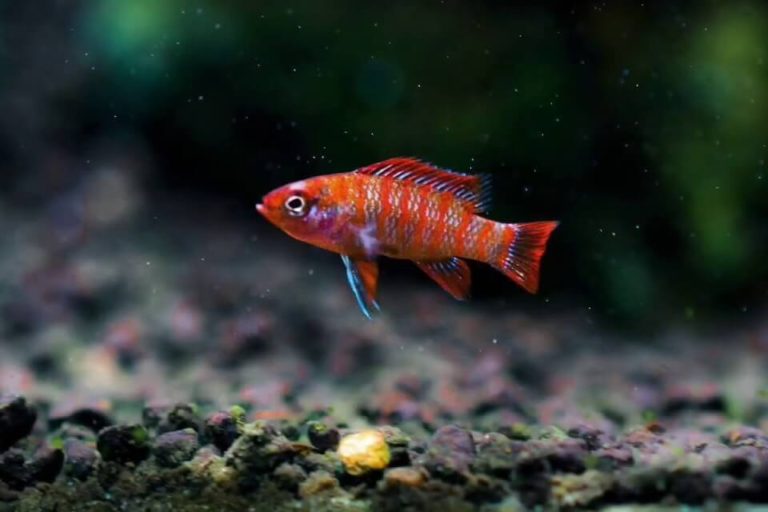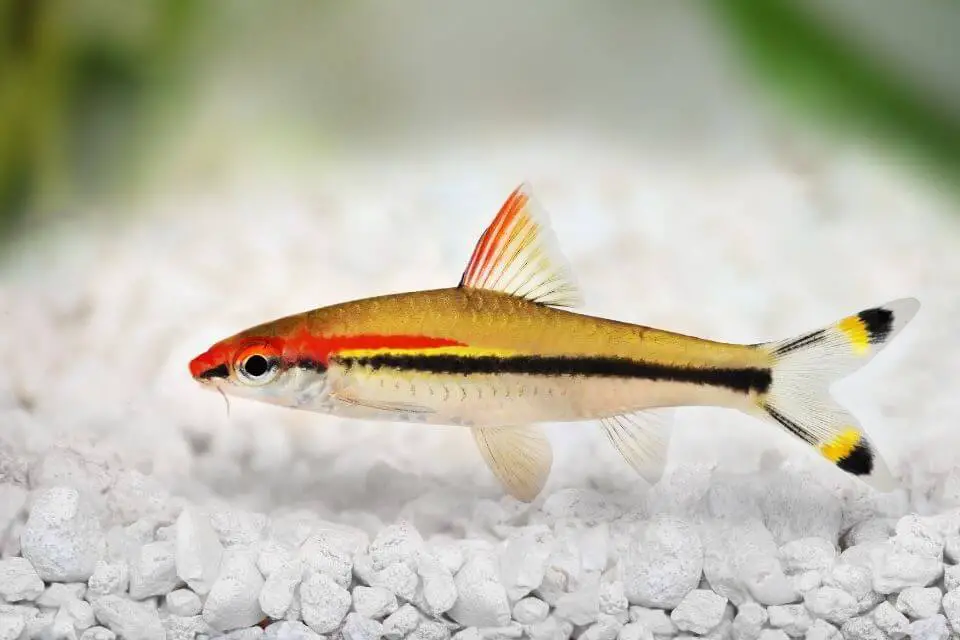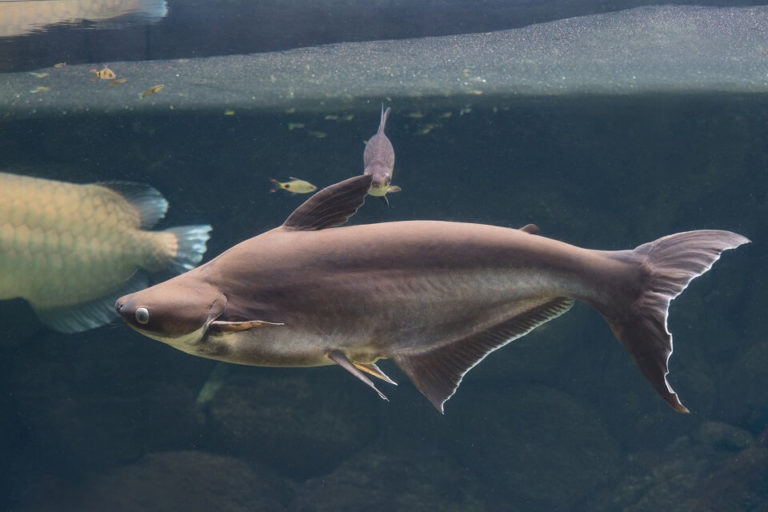Peacock Gudgeon Care 101: Tank Size, Tank Mates and Food
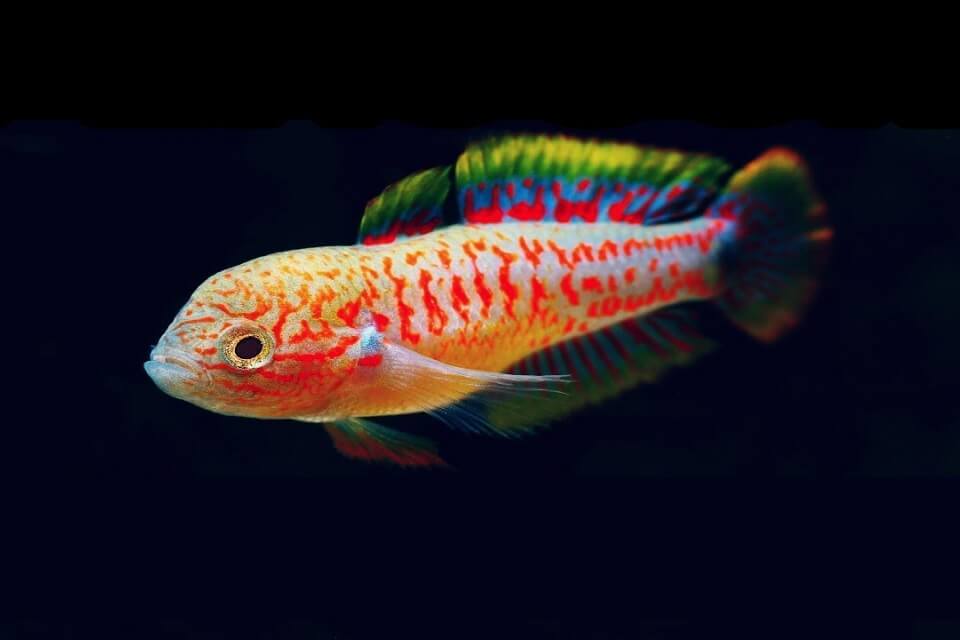
Peacock Gudgeon is bright-colored, incredibly beautiful, and interesting freshwater fish species. These unique freshwater beauties have a very distinct peacock-like appearance.
The most distinct feature about these fish is their peacock-like colors and markings (as their name suggests) and you can be sure that they will add both liveliness and vibrancy when reared in an aquarium.
This fish is a low-maintenance fish, although, like any other fish, it requires a real treat to remain healthy and full of spirit. If you are a fan of ornamental fish species, get ready as this vivid fish is about to make this post-action-packed.
Here, we will explore everything you need to know about the Peacock Gudgeon fish and hopefully educate anyone looking to keep this fish in their freshwater aquarium.
| Quick Facts: | |
|---|---|
| Common Names | : Peacock Gudgeon, Peacock Goby |
| Scientific Name | : Tateurndina ocellicauda |
| Family | : Eleotridae |
| Origin | : Shallow water bodies of the Eastern parts of Papua Guinea |
| Care Level | : Easy |
| Lifespan | : 4 - 5 years |
| Size (average) | : 2 - 3 inches long |
| Diet | : Omnivores |
| Breeding | : Egglayer |
| Social | : Community fish |
| Temperament | : Peaceful |
| Minimum Tank Size | : 15 gallons |
| Temperature | : 72 - 79 ° F (22 - 26 °C) |
| Water Hardness | : 5 - 12 dKH |
| Water pH Level | : 6.5 - 8 |
Overview of Peacock Gudgeon
It is also known as Peacock Goby and the scientific name is Tateurndina ocellicauda. They belong to the Eleotridae family. These fish are small-sized, beautifully colored/marked shallow freshwater swimmer fish.
Most of their original species are found in shallow water bodies of the Eastern parts of Papua Guinea Islands and the surrounding areas.
The body is generally bluish with a silvery shine. There are pink, yellow, and black markings all over their body and a distinctive black spot just where the tail begins.
The dorsal, anal, and tail fins have a light blue shade with black or yellow edges. The spots on the fins can also appear red if closely viewed.
Peacock Gudgeon is low maintenance and does not demand much when reared in a tank. As long as there is clean, gently flowing water and enough high-quality food, these fish will always remain happy and healthy.
To respond to their peaceful calm nature, you must provide them with enough room and shelter to freely swim and jump over.
They are omnivores but prefer to feed on live foods. Although seasoned fish keepers have trained their fish to feed on fish food pellets, this kind of food is not their favorite.
Optimum water conditions and parameters must be maintained at all times as this fish is highly susceptible to infectious diseases. The water temperature should be between 72 and 79° F (22 to 26° C) and the pH around 6.5 to 8.
An optimal cared Peacock Gudgeon fish will grow up to 4 inches and live up to 5 years. Proper care also means that their colors will fully develop to brighten and liven up your Aquarium properly.
Peacock Gudgeon Size
In a captive setting, the male Peacock Gudgeon size will grow up to 3 inches long, while the females will grow up to 2 inches. Juvenile Peacock Gudgeon size will attain this length after 6 to 8 months when well fed and taken care of.
Even though some will still grow bigger even past this period, many will mainly reach their maximum length at this stage.
The wild varieties will effortlessly clock this size by the time they are six months old and it is not a wonder to see them grow even an inch longer past this size.
Peacock Gudgeon Lifespan
A well-fed fish living in optimum tank conditions and water parameters will live up to 4 to 5 years. Wild varieties will live more than in this period as the conditions in these environments are more favorable.
Poor water conditions, whether in the wild or tank environments, can reduce their lifespan significantly as this will host a wide variety of diseases that can be life-threatening.
Peacock Gudgeon Typical Behavior
It is a peaceful, calm, and non-aggressive fish species. This fish is not only non-aggressive but also non-demanding. It will live well with a wide variety of common tank fish species (as discussed in the tank mates section)
Also, prefer to live in groups rather than couples when kept with other Peacock Gudgeons. Even if they get a little aggressive, they will only scare the rivals off without any intention of attacking.
These fish species like a tank with enough shelter and if this is not provided, they may stick together and greatly minimize their swimming and movements.
This is, of course, a health-threatening condition and hence you should be very strategic in how to set up your freshwater tank components.
The Peacock Gudgeon will swim freely and peacefully if the water is clean and flowing gently. Strongly moving low-quality water will make these fish uncomfortable and unhappy. This is supported by the fact that they are slow swimmers.
Appearance and Colors
It is a vividly colored fish and both the males and females will exhibit bluish and silvery bodies. A male Peacock Gudgeon will, however, have more popping colors than the females.
During spawning, the females are distinct as their abdomen is brightly yellow-colored. There is a black spot where the tail fin begins that often appears blurred.
Generally, all the fins are transparent, but with a closer look, you will notice that they have a light blue theme with red spots. The edges of the dorsal fins are yellow-colored for the males and black or dull for the females.
It is not just about the popping colors, they also feature very special markings throughout its body and fins. Generally, an adult Peacock Gudgeon fish will have pink, black, and yellow patterned markings.
The beautiful combination of popping colors and special markings is the reason why the term ‘Peacock’ is attached to their name. It is needless to say that this is the same reason why these fish are popular aquarium species.
Peacock Gudgeon Care
Unlike other tank fish, caring for them is pretty easy. Whether kept with fellow Gudgeons or other tank fish species, they will happily live together and demand less than most of the fish you keep in the Aquarium.
Even with this, you will still need to set up some conditions and parameters as discussed below:
– Peacock Gudgeon Tank Size
Despite this fish being small-sized, you can accommodate 4 to 6 fish in a 10 gallons tank, but we experienced that it is not a reasonable tank space for them to survive.
We highly recommend that you should require at least a 15 gallons tank to house 4 to 6 fish. Also, you might need 20 gallons or more tank for 6 specimens and more. Add 2 gallons of tank space per single fish accordingly.
However, this is still less space compared to what other tank fish require and is, of course, attributed to the fact that Peacock Gudgeons are not strong swimmers.
If you want to keep the fish in a community, then a larger community tank is required basing your calculations on all the fish tank-size requirements.
– Peacock Gudgeon Tank Setup
Generally, these fish prefer a rock and sand bottom substrate. Avoid gravels as they may cut the edge of their fins as they swim. The bottom substrate should be dark enough to allow the fish to display its exquisite beauty hassle-free.
This should be supported by dim lighting. You can light up with a dimmable LED Aquarium Light Panel.
You can add some small pieces of driftwoods to the tanks for the decorations and some rocks on the bottom to increase the hiding places for insecure Peacock Gudgeons or shelter for the territorial ones.
It would also help if you got a little creative and arranged the rocks to form cave-like structures. Since these fish are not strong swimmers, you are not limited to the decorations you can add to the tank.
However, leave a sensible room where they can horizontally swim and jump up and down when Peacock Gudgeon feels like displaying their unmatched beauty.
Considering that these fish are excellent jumpers, you should ensure that there are no gaps around the tank lid. Especially the male varieties may show territorial dominance, you should also provide shelter, probably in the form of caves or snags.
This will also add to the hiding places provided by tank plants, as discussed below.
Suitable Plants
Peacock Gudgeon will do well in a large number of floating plants. The plants need to be hardy as these fish love to play with them. Plants also provide perfect hiding places for these fish.
The most preferred plants are the Water Wisteria, Java fern, Anubias, and sometimes a little Java moss at the tank’s bottom. The more hiding places in the tank (plants, rocks, and wood), the better environment for them.
Water Temperature and Parameters
The water should be maintained at a temperature of 72 to 79 ° F (22 to 26 °C) and a pH of around 6.5 to 8. It should be fairly soft with a hardness of 5 to 12 dKH.
These conditions should be kept constant as fluctuations may not go well with these fish species. They like clean, well-aerated, and gently flowing water.
The fish may feel disturbed if the water current is so strong for them. Although it is not a must requirement, it would help if the tank water is constantly filtered to ensure that it is of the required quality at all times.
Partial water renewal (at least 20%) should also be done at least once a week.
Diet: What do Peacock Gudgeons Eat?
They are omnivores and will mainly feed on live foods. Although you may still train them to take fish food pellets, many don’t like dry foods.
If you manage to train them to eat dry foods, you should only feed them with high-quality API fish food pellets or Zoo Med Spirulina flake food to keep the fish healthy and the tank clean.
These fish may also prefer small-sized frozen brine shrimp, bloodworm, and daphnia. Keep in mind that the right diet will make these fish healthy, attain optimum coloration early, and come into a spawning condition in the required period.
Always give the fish enough food and don’t at any time overfeed them as the excess food may deposit at the bottom substrate lowering the water quality and increasing the risk of diseases.
Common Diseases of Peacock Gudgeon
This is probably one area you will have to be highly conscious of when keeping the Peacock Gudgeons. These fish are prone to a wide variety of infectious diseases and although this is common to many tank fish.
Especially when the right tank conditions are not maintained, many of the infections may easily cause death.
Their high susceptibility to infectious diseases is always related to the long transportation they are likely subjected to from South East Asia to their destinations.
The common diseases are caused by parasites and fungi and include the notorious white spot disease, anchor worms, marine velvet, skin or gill flukes, hole-in-the-head disease, tuberculosis, and dropsy.
The fish is not spared from common conditions such as the freshwater Ich.
Common symptoms of these health conditions are lack of movement, loss of their usual colorations, swelling of the bottom body section, clamped fins, white spots, loss of appetite, etc.
It is always advisable to engage a vet right on observing these symptoms.
Even with this kind of susceptibility and all these conditions, the right tank, water, food, and water conditions will keep the fish healthy and see it brightening and livening up your Aquarium for at least 4 to 5 years.
Peacock Gudgeon Gender Differences
- Generally, the males are larger than the females except during spawning when the females are larger and fuller with a rounder abdomen.
- Like many tank fish, the male Peacock Gudgeons have brighter colors compared to the females. During spawning, the females have a brightly yellow-colored abdomen than the males.
- The males have a bigger head with a high forehead, while the females have a smaller head with a receding forehead.
- The anal and dorsal fins of the males have brightly colored yellow edges, while that of the females have dull black edges.
- During mating, the male’s abdominal fins are dark brown with a blue tint while that of the females are black.
Peacock Gudgeon Breeding
At the age of 6 to 8 months, their breeding starts. In most cases, ready to reproduce and unlike other aquarium fish, it is relatively easy to breed this fish.
It likes to breed in couples and should be preferably put in a spawning tank separate from the community tank to initiate the process. For better results, put them in groups of 6 to 8 fish.
Before mating, you will see the male Peacock Gudgeon display a characteristic dance around the females and then move the female’s fins into place. During mating, the males’ abdominal fins turn dark brown while that of the females turn black.
Suitable Tank Conditions for Breeding
Mating best occurs at a tank water temperature of about 23 to 28 °C (73 to 82 ° F) or 1 to 2 degrees higher than the community tank’s temperature. The water should also be maintained at pH 7.
You cannot fail to notice a female that is ready to spawn as it is always rounded with a fuller abdomen. The spawning tank should have hiding places/shelters where the females will lay the eggs.
A typical Peacock Gudgeon female will lay 50 to 100 eggs and should immediately be removed from the spawning tank for the males to do the rest of the work.
The male Peacock Gudgeon is an excellent guarder and will take care of both the fertilized eggs and the offspring. Unlike many tank fish, the male species will stay in the spawning tank the entire time and actively fan the eggs using their fins.
This improves oxygen circulation and keeps the eggs fully nourished. With proper oxygen supply and the right tank temperature, the larvae (transparent) emerge after around 7 to 10 days.
The juveniles start to swim about 2 to 4 days after the larvae emerge. Feeding with mainly brine shrimp or any other microfauna should be introduced at this stage.
With the right feeding and tank conditions, the juveniles should grow at a rate of 1cm every month and attain the parents’ full coloring in about 4 months.
Peacock Gudgeon Tank Mates
They are peaceful and non-aggressive fish and are compatible with a wide variety of tank fish species. It is a perfect community fish and will not disturb other community members even if they are the largest species in the tank.
You should, however, avoid extremely small fish like some shrimp varieties (For example- the cherry shrimp) as the males may sometimes display territory dependence.
In the same spirit, avoid fast swimmers and extremely aggressive fish in the community tank where there are Peacock Gudgeons as this may make this peaceful fish feel threatened.
In unavoidable circumstances, you should at least provide enough shelter in the tank where it will hide when they feel insecure. Also, provide enough food to ensure that they get their share as other fish feed.
Excellent Peacock Gudgeon tank mates are the Papua New Guinea varieties, including;
- Congo Tetra
- Ember Tetra
- Galaxy Rasbora
- Corydoras Catfish
- Bumblebee Goby
- Apistogramma
- Cherry Barb
- Zebra Danio
- Bristlenose Pleco
Origin, Distribution, and Availability
It is native to shallow waters in the Southeastern parts of Papua Guinea Island. They are also found in lowland streams, rivers, and ponds near this Island.
There is also a decent population of these fish in the ponds and shallow waters of the tropical forest ponds. Being a beautiful and excellent community dweller.
These fish species were quickly transported from Southeast Asia to other parts of the world, where they are bred and sold to enthusiastic fish keepers.
Today, you will find Peacock Gudgeon for sale in popular aquarium fish markets. Every reliable fish store will have an authentic breed for sale. It will be available in many pet stores at reasonable prices.
Are Peacock Gudgeons Aggressive?
No, they are very peaceful and calm fish. This is not the kind of fish you will push to attack easily, as even if they feel insecure, they will exhibit behaviors that will only scare their rivals.
Even with this kind of behavior, you should keep them with other non-aggressive fish species of almost the same size.
Will Peacock Gudgeons Eat Shrimp?
Don’t be fooled by their small size and peaceful nature, as even the smallest and calmest fish will still eat shrimp. Although they will not eat the adult shrimps, they will snack on the smaller ones or any shrimp fry in the tank.
Do Peacock Gudgeons Jump?
They jump easily and this is expected since they are not excellent swimmers. This is the reason why there should be no gaps around the tank lid you have put in place. However, for this to happen, the water should be flowing gently.
Final Thoughts
Absolutely yes, if you like your Aquarium lively and vividly colored by peaceful yet low maintenance fish. This is also one of the perfect choices you can have for a community tank, thanks to its calm, non-aggressive characteristics.
Any aquarist or tank fish keeper looking for small bright fish will definitely fall in love with the Peacock Gudgeons. It is a beautiful fish and the only way to maintain its vibrancy for a long time is by treating it right.
Just follow all the tank instructions discussed above and you will never go wrong with them. Also keep in mind that aquarium fish rearing becomes much easier with absolutely any fish when you stick to specific tank, water, and food conditions.
Finally, make sure that you source your Peacock Gudgeon from a reliable pet store to get a healthy and disease-free breed when you start.



